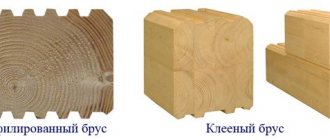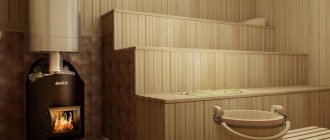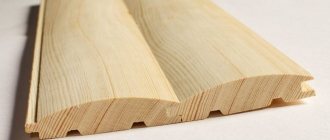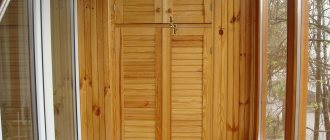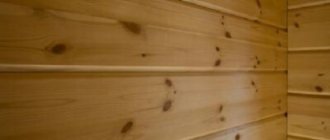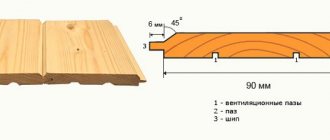The popularity of using lining is increasing every day. And there are good reasons for this:
- lining is a universal material that is suitable for finishing both external and internal walls;
- the cost makes it accessible to the general public;
- The wide range of materials used in production allows it to be used in a wide variety of design projects.
But no matter what lining is chosen, errors in calculating the required amount of material can not only disrupt the current repair process, but also significantly change the expected finishing result.
General information about lining and its calculation
Lining, a finishing material made from natural wood, has long been used for cladding walls both outside and inside. To understand how much of this material is needed for a specific purpose, you can use a calculator, but it is also useful to know how to make such lining calculations yourself.
Calculations can be made in several ways. So, for this, the following data can be used: length, width, height of the sheathed room, area or other dimensions and parameters of the lining board itself. If you are installing it on walls and other surfaces in the house, it is logical that the room most likely has window and door openings for which you will not have to waste material. In this case, the area of these elements is subtracted from the total area of the walls and the so-called working S is obtained.
Since the width and length of different types of lining are different, this point should also be taken into account when making calculations using a calculator. After entering all the necessary data and pressing the enter button, the calculator instantly performs the necessary calculations. The result of the calculation will be the minimum amount of wooden material in pieces.
This is what a sheathed room looks like Source lesobirzha.ru
Important! In order not to make a mistake in the amount of finishing material purchased, it is better to add another 10-15% to the result obtained.
The lining calculator for walls and ceilings takes into account the parameters of this material. At the same time, it is important to separate the calculation of boards sold in cubic meters, square meters or in pieces. Let's give an example of converting pieces to square or cubic meters.
Let's say you plan to purchase a lining that is sold individually and has dimensions of 15 mm * 120 mm * 3000 mm (thickness, width and length, respectively). If you need to convert measurements into square meters, that is, calculate the S of each board, you need to use its length and width in the calculations (thickness in this case is not needed).
First you need to convert these values from millimeters to meters. Since there are 100 centimeters in one meter or 100 * 10 = 1000 millimeters, we make the following calculation:
- board length – 3000 mm = 3000 / 1000 = 3 m,
- board width – 120 mm = 120 / 1000 = 0.12 m.
Let's look at how to calculate lining in square meters. You can calculate the area of the clapboard board. To do this you will need to do the following mathematical operation:
S = length * width = 3 * 0.12 = 0.36 square meters = 0.36 m2.
Calculation using a calculator Source povagonke.ru
See also: Catalog of companies that specialize in finishing materials and related work
To calculate the volume of each board, you must also use the numerical value of its thickness. Let's convert the thickness of the lining, expressed in millimeters, into meters: 15 mm / 1000 = 0.015 m. Now we apply the following formula:
volume = area * thickness = 0.36 * 0.015 = 0.0054 cubic meters = 0.0054 m3.
Now, if you have a number expressing the total volume of the lining, you can calculate its number in pieces. To do this, you just need to divide this number by the previously calculated value of the volume of one board. So, one cubic meter of the indicated dimensions contains 1 / 0.0054 = 185.19 = 185 whole boards (the value is rounded).
If you know the number showing S of the lining that will be used for finishing work, you can calculate the number of boards in this way: you need to divide the available number of the total processed area by the area of \u200b\u200bone lining board. Calculations for five square meters of material in this case will look like this:
5 / 0.36 = 13.89 = 13 whole boards (almost 14 pieces).
Lining packaging Source rost.specdispetcher.ru
When it is necessary to make reverse calculations, that is, by the number of boards, calculate how much it is in square or cubic meters, you need to do the following manipulations. Let's say there are 20 lining boards, then it will be in m2 or m3, respectively:
- 20 * 0.36 m2 = 7.2 m2;
- 20 * 0.0054 m3 = 0.108 m3.
What's the best way to calculate?
When finalizing the design of your bathhouse building from the point of view of determining the material consumption of interior decoration, you can rely on a simplified calculation method (by area) or approach the solution of the problem in more depth, and also choose some intermediate approach. The operation of most relevant online services is based on the simplified calculation algorithm, or preliminary quick estimates are made manually. This method gives an understanding of the required approximate budget to bring the building to a residential condition. Calculating the lining by area allows you not to delve into the intricacies of the problem, which will save you time, but purchases based on it will require additional expenditure on the supply of boards for trimming.
The procedure for calculating the lining
If a wall paneling calculator is not available, you can calculate it manually. For example, you need to completely sheathe a rectangular room in a house. For calculations, you need to know what the width, length and height of the room are. In addition, you should measure the parameters of door and window openings. Let's say that in the room under consideration with dimensions of 3 m by 4 m and a ceiling height of 2.35 m, there is one rectangular doorway and one window (also of a rectangular classical shape). The height of the doorway is 2 m and the width is 0.7 m; The window height is 1.41 meters and the width is 2.03 meters.
Let's calculate the area of the ceiling (it will also be the area of the floor). To do this, you just need to multiply the width of the room by the length, that is:
S ceiling = 3 m * 4 m = 12 m2.
Calculation of attic area
The shape of the attic is significantly different from the premises on the first floor, so you need to learn how to calculate its square footage. The simplest attic space consists of gables, as well as side planes.
- We determine the total area of the two fronts by multiplying the height by the length of the base: 4 x 6 = 24;
- We calculate the total area of the side planes. To do this, measure the slope from the very bottom to the ridge. Then we multiply by the distance between the two gables and double the resulting number: 5 x 4 x 2= 40;
- Let's sum up the obtained values: 40 24 =64 (square meters);
- We add the area of the first floor to the resulting number.
What else do you need to know about lining boards?
The board, called lining, differs not only in its size, it can be made from different types of wood. Thus, larch perfectly withstands high temperatures and high humidity, which is why lining made from this wood is used in steam rooms and saunas.
Good oak is used for interior cladding of a private house. This material will not rot or lose color over time. Spruce and other coniferous wood can “take root” in dressing rooms and other auxiliary rooms. This material is cheaper, but less resistant to external influences compared to the above options.
Wood selection
Today, the construction market is filled with a variety of options for finishing materials, so for a beginner in repair and construction, choosing lining can be a serious challenge.
The main thing that a buyer must go to the market with is the concept of the exact value of the required amount of material. This approach will help prevent some uncomfortable situations. After all, buying extra materials leads not only to a loss of money, but also time for its possible return.
Important! When choosing wooden lining, special attention should be paid to the type of wood from which it is made. The most common options are deciduous and coniferous wood.
Let's look at the types of trees most commonly used in lining production:
- Pine. It is distinguished by high strength indicators, which attracts consumers. However, you need to know that pine lining quickly loses its original color if it is not treated with protective varnish or stain.
- Oak. The beautiful structure of the wood, which practically does not rot, makes this lining a leader in the ranking of the popularity of finishing materials. Its only drawback is the high price, which is not affordable for everyone.
- Ash. It is not used very often because processing such wood is quite labor-intensive and costly. But at the same time, ash wood is very durable and does not change its structure and shape when dried.
- Linden is an ideal option for arranging steam rooms in a bathhouse or sauna. It retains heat perfectly without emitting resin oils that are harmful to human health.
Briefly about the main thing
Lining is a material for finishing work, made of wood and having a special design with “locks” that facilitate its installation.
Calculating the lining with a calculator helps to find out how many packages of this building material need to be purchased for the intended purpose.
When calculating the amount of lining boards for cladding, you need to take into account the parameters of the lining, the room (premises), as well as the presence and size of openings.
Lining can be sold per piece or per square or cubic meter.
To find out how much lining there is in 1 m2, you need to make simple calculations or enter the required values into the appropriate columns of a special calculator.
Ratings 0
Types of wood
The quality of the lumber and, as a consequence, the final appearance of the product, significantly affects the price of the lining.
There are four main types of wood that can affect the cost:
- category "Extra". This is the highest class of wood, which has no knots, cracks or other defects on its surface;
- class “A” is assigned to wood that can have one or two knots per linear meter of board;
- class “B” assumes that there are dark-colored defects on the surface of the wood, up to 1 cm in diameter;
- class “C” is assigned to the lowest quality wood from which lining of the appropriate price and quality is produced.
It is not difficult to calculate the required amount of material. If any difficulties arise, the seller of the product will always come to the rescue. The main thing is to make all calculations on time, before the transaction is completed. This will help save money and prevent a situation where a very large amount of trim remains after repairs.
Of course, there should be a supply of lining, but within reasonable limits. As a rule, experts recommend adding 10-15% of the reserve to the calculated value of the required amount of material.
Important! When choosing a forcing, take into account the functional purpose of the room where the finishing work will take place.
Measuring room parameters
The length and width of the room (assuming smooth walls) are measured along the floor, along the corner or baseboard. It is better to measure the height of the room along the angle between the walls. When measuring the height and width of windows, you do not need the height of the frame or transom itself, but the slopes. It is easy to measure the width along the window sill, the height - from the bottom plane of the window sill up to the horizontal slope.
The door parameters should also be measured not by the leaf, but by the distance between the sides of the opening (between the door frame or already installed finishing parts - it all depends on how the sheets will be mounted).
Example:
- Lining 96mm wide, 12.5mm thick, 6m long, packed in packs of 10 pcs. A square meter of lining costs 220 rubles. It is written like this: 96x12.5x6000mm
- How many square meters does one pack of lining cover and how many rubles does it cost?
- How many square meters (m2) will cover a cubic meter (m3) with a board 12.5 mm thick.
| Photo of the lining of this section. Packed in packs of 10 pcs. |
The thickness of the lining is 12.5 mm. convert to meters – 0.0125m.
the width of the lining is 96mm, converted to meters – 0.096m.
- 0.096 m (width of the lining) x 6 m. (lining length) x 10 pcs. in a pack = 5.76 m2 covered by one pack of lining
- 5.76 m2 x 220 rub. = 1,267.2 rub. will cost one pack of lining.
- RUB 1,267.2: 10 pcs. in a pack = 126.72 rubles. one costs 6m. clapboard board.
- From the article “How to count m2 and convert to m3.” it follows that 1 m3 of a given lining profile covers 80 m2.
| SECTION WIDTH THICKNESS IN MM. | CLASS | PACKAGE PCS. | PACKAGING CLOSE M2 | 1M3 COVERS M2 | PRICE 1m2 IN RUB. | PACKAGING PRICE IN RUB. | PRICE 1m3 IN RUB. |
| 96x12.5x6000 | A | 10 | 5.76 | 80 | 220 | 1267 | 17600 |

